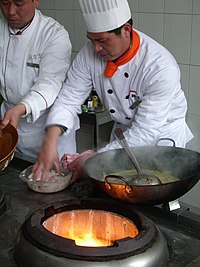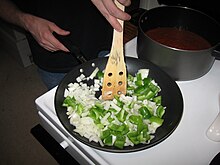Cooking


Cooking is the process of preparing food by applying heat, selecting, measuring and combining of ingredients in an ordered procedure for producing safe and edible food. The process encompasses a vast range of methods, tools and combinations of ingredients to alter the flavor or digestibility of food. Factors affecting the final outcome include the variability of ingredients, ambient conditions, tools, and the skill of the individual doing the actual cooking.
The diversity of cooking worldwide is a reflection of the myriad nutritional, aesthetic, agricultural, economic, cultural, social and religious considerations that impact upon it.
Applying heat to a food usually, though not always, chemically transforms it, thus changing its flavor, texture, consistency, appearance, and nutritional properties. Other methods of cooking that involve the boiling of liquid in a receptacle have been practiced at least since the 10th millennium BC, with the introduction of pottery. [citation needed]
Effects of cooking
Cooking prevents many food borne illnesses that would otherwise occur if the raw food was eaten. Also, cooking increases the digestibility of many foods, especially meat.[1]
Nutrients
Proteins
Edible animal material, including muscle, offal, milk and egg white, contains substantial amounts of protein. Almost all vegetable matter (in particular legumes and seeds) also includes proteins, although generally in smaller amounts, by weight. (When considered as a proportion of total calories, plant foods often contain a greater proportion of protein than animal foods. Broccoli, for example, contains a higher proportion of protein than ground beef.)[citation needed]
These foods may also be a source of essential amino acids. When proteins are heated they become de-natured and change texture. In many cases, this causes the structure of the material to become softer or more friable - meat becomes cooked. In some cases, proteins can form more rigid structures, such as the coagulation of albumen in egg whites. The formation of a relatively rigid but flexible matrix from egg white provides an important component of much cake cookery, and also underpins many desserts based on meringue.
Liquids
Cooking often involves water which is frequently present as other liquids, both added in order to immerse the substances being cooked (typically water, stock or wine), and released from the foods themselves. Liquids are so important to cooking that the name of the cooking method used may be based on how the liquid is combined with the food, as in steaming, simmering, boiling, braising and blanching. Heating liquid in an open container results in rapidly increased evaporation, which concentrates the remaining flavor and ingredients - this is a critical component of both stewing and sauce making.
Fat
Fats and oils come from both animal and plant sources. In cooking, fats provide tastes and textures. When used as the principal cooking medium (rather than water), they also allow the cook access to a wide range of cooking temperatures. Common oil-cooking techniques include sautéing, stir-frying, and deep-frying. Commonly used fats and oils include butter; olive oil; vegetable oils such as sunflower oil, corn oil, and safflower oil; animal fats such as lard, schmaltz, and beef fat (both dripping and tallow); and seed oils such as rapeseed oil (Canola or mustard oil), sesame oil, soybean oil, and peanut oil. The inclusion of fats tends to add flavor to cooked food, even though the taste of the oil on its own is often unpleasant. This fact has encouraged the popularity of high fat foods, many of which are classified as junk food.
Carbohydrates
Carbohydrates include simple sugars such as glucose (from table sugar) and fructose (from fruit), and starches from sources such as cereal flour, rice, arrowroot, potato. The interaction of heat and carbohydrate is complex.
Long-chain sugars such as starch tend to break down into more simple sugars when cooked, while simple sugars can form syrups. If sugars are heated so that all water of crystallization is driven off, then caramelization starts, with the sugar undergoing thermal decomposition with the formation of carbon, and other breakdown products producing caramel. Similarly, the heating of sugars and proteins elicits the Maillard reaction, a basic flavor-enhancing technique.
An emulsion of starch with fat or water can, when gently heated, provide thickening to the dish being cooked. In European cooking, a mixture of butter and flour called a roux is used to thicken liquids to make stews or sauces. In Asian cooking, a similar effect is obtained from a mixture of rice or corn starch and water. These techniques rely on the properties of starches to create simpler mucilaginous saccharides during cooking, which causes the familiar thickening of sauces. This thickening will break down, however, under additional heat.
Cooking methods
For various cooking methods, see Category: Cooking techniques.
Food safety

If heat is used in the preparation of food, this can kill or inactivate potentially harmful organisms including bacteria and viruses. The effect will depend on temperature, cooking time, and technique used. The temperature range from 41°F to 135°F (5°C to 57°C) is the "food danger zone." Between these temperatures bacteria can grow rapidly. Under optimal conditions, E. coli, for example, can double in number every twenty minutes. The food may not appear any different or spoiled but can be harmful to anyone who eats it. Meat, poultry, dairy products, and other prepared food must be kept outside of the "food danger zone" to remain safe to eat. Refrigeration and freezing do not kill bacteria, but only slow their growth. When cooling hot food, it shouldn't be left on the side or in a blast chiller (an appliance used to quickly cool food) for more than 90 minutes.
Cutting boards are a potential breeding ground for bacteria, and can be quite hazardous unless safety precautions are taken. Plastic cutting boards are less porous than wood and have conventionally been assumed to be far less likely to harbor bacteria.[2] This has been debated, and some research have shown wooden boards are far better.[3] Washing and sanitizing cutting boards is highly recommended, especially after use with raw meat, poultry, or seafood. Hot water and soap followed by a rinse with an antibacterial cleaner (dilute bleach is common in a mixture of 1 tablespoon per gallon of water, as at that dilution it is considered food safe, though some professionals choose not to use this method because they believe it could taint some foods), or a trip through a dishwasher with a "sanitize" cycle, are effective methods for reducing the risk of illness due to contaminated cooking implements.[3]
Potential harmful health effects
Researchers at the University of Toronto and another published in the Journal of the National Cancer Institute suggest that ingesting uncooked or unpasteurized dairy products (see also Raw milk) may reduce the risk of colon cancer. Mice and rats fed uncooked sucrose, casein, and beef tallow had one-third to one-fifth the incidence of microadenomas as the mice and rats fed the same ingredients cooked.[4][5]
Several studies published since 1990 indicate that cooking muscle meat creates heterocyclic amines (HCAs), which are thought to increase cancer risk in humans. Researchers at the National Cancer Institute found that human subjects who ate beef rare or medium-rare had less than one third the risk of stomach cancer than those who ate beef medium-well or well-done.[6] While eating muscle meat raw may be the only way to avoid HCAs fully, the National Cancer Institute states that cooking meat below 212 °F (100 °C) creates "negligible amounts" of HCAs. Also, microwaving meat before cooking may reduce HCAs by 90%.[7] Nitrosamines, present in processed and cooked foods, have also been noted as being carcinogenic, being linked to colon cancer.
Also, toxic compounds called PAHs, or Polycyclic aromatic hydrocarbons, present in processed, smoked and cooked foods, are known to be carcinogenic.[8] German research in 2003 showed significant benefits in reducing breast cancer risk when large amounts of raw vegetable matter are included in the diet. The authors attribute some of this effect to heat-labile phytonutrients.[9]
Heating sugars with proteins or fats can produce Advanced glycation end products ("glycotoxins").[10]
Science of cooking

The application of scientific knowledge to cooking and gastronomy has become known as molecular gastronomy. This is a sub discipline of food science. Important contributions have been made by scientists, chefs and authors such as Herve This (chemist), Nicholas Kurti (physicist), Peter Barham (physicist), Harold McGee (author), Shirley Corriher (biochemist, author), Heston Blumenthal (chef), Ferran Adria (chef), Robert Wolke (chemist, author) and Pierre Gagnaire (chef).
History of cooking
There is, as yet, no clear evidence as to when cooking was invented. Richard Wrangham argues that cooking was invented as far back as 1.8 million to 2.3 million years ago. Other researchers believe that cooking was invented as late as 40,000 or 10,000 years ago. Evidence of fire is inconclusive as wildfires started by lightning-strikes are still common in East Africa and other wild areas, and it is difficult to determine as to when fire was used for cooking, as opposed to just for warmth or keeping predators away. While many anthropologists place the advent of cooking at around 250,000 years ago, anthropologists besides Wrangham suggest that cooking did indeed occur much earlier, evidenced by archeological findings at Zhoukoudian in China, at Chesnowanja, Swartkrans and Koobi Fora in Africa, the latter of which has been dated by the "potassium-argon method to approximately 1.6 million years ago".[11]
See also
- Main list: List of basic cooking topics
- High altitude cooking
- Carry over cooking
- Control of fire by early humans
- Cooker
- Cooking weights and measures
- International food terms
- Food and cooking hygiene
- Dishwashing
- Food preservation
- Food writing
- List of food preparation utensils
- Cuisine
- Recipe
- List of recipes
- Nutrition
- Staple (cooking)
- Culinary profession
- Culinary art
- Gourmet Library and museum
References
- ^ Clifford, WM (1930). "The effect of cooking on the digestibility of meat". The Biochemical Journal. 24 (6): 1728–1733. PMID 16744523.
- ^ "Cutting Boards (Plastic Versus Wood)". Food Safety, Preparation and Storage Tips. Cooperative Extension, College of Agriculture & Life Sciences, the University of Arizona. 1998. Retrieved 2006-06-21.
- ^ a b "Cutting Boards - wood or plastic?". ReluctantGourmet.com. Retrieved 2006-06-21.
- ^ Promotion of colonic microadenoma growth in mice and rats fed cooked sugar or cooked casein and fat
- ^ Promotion of Aberrant Crypt Foci and Cancer in Rat Colon by Thermolyzed Protein
- ^ http://www.cancer.gov/cancertopics/factsheet/Risk/heterocyclic-amines National Cancer Institute - Heterocyclic Amines in Cooked Meats
- ^ http://www.cancer.gov/cancertopics/factsheet/Risk/heterocyclic-amines
- ^ http://ec.europa.eu/food/fs/sc/scf/out154_en.pdf
- ^ Nutr Cancer. 2003;46(2):131-7
- ^ Koschinsky T, He CJ, Mitsuhashi T, Bucala R, Liu C, Buenting C, Heitmann K, Vlassara H (1997). "Orally absorbed reactive glycation products (glycotoxins): an environmental risk factor in diabetic nephropathy". Proceedings of the National Academy of Sciences (USA). 94 (12): 6474–6479. doi:10.1073/pnas.94.12.6474. PMID 9177242.
{{cite journal}}: CS1 maint: multiple names: authors list (link) - ^ http://cogweb.ucla.edu/Abstracts/Pennisi_99.html
